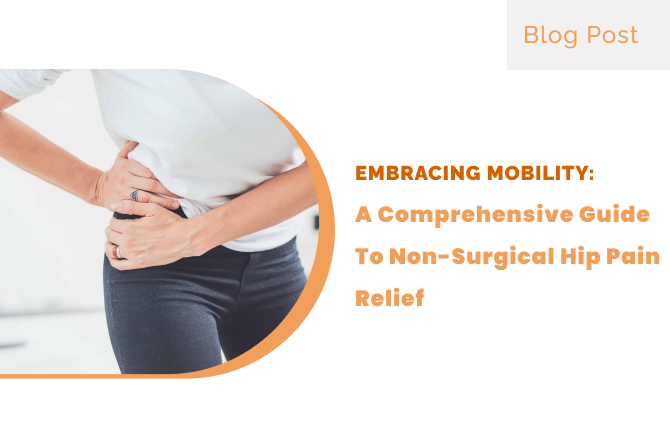Embracing Mobility: A Comprehensive Guide to Non-Surgical Hip Pain Relief

Non-Surgical Hip Pain Relief
Overview
The incidence of hip discomfort can have a profound impact on an individual’s quality of life, impeding their ability to move, obtain restful sleep, and sustain overall well-being. Whether attributed to physical trauma, arthritic conditions, or excessive strain, many individuals seek alternative methods of alleviation that do not necessitate surgical intervention. Fortunately, a wide range of non-surgical modalities exists to address hip pain, offering a beacon of hope for enhanced comfort and mobility. Within this comprehensive compendium, we will explore diverse strategies and techniques meticulously designed to ameliorate hip-related discomfort and restore optimal functionality, empowering individuals to seize command of their health and embrace a life brimming with unfettered mobility and vitality.
Hip Pain
The hip joint is a remarkable example of biomechanical ingenuity, incorporating a complex system of bone structures, articular cartilage, ligaments, muscles, and tendons that work together seamlessly to support the body’s weight and facilitate smooth movement. Various factors can contribute to hip discomfort, including conditions like osteoarthritis and rheumatoid arthritis, as well as issues such as bursitis, tendonitis, muscle strains, and traumatic events. Identifying the root cause of hip pain is of utmost importance when designing a personalized treatment plan that addresses individual needs effectively.
Non-Surgical Treatment Options
- Physical Therapy: Physical therapy plays a crucial role in effectively managing hip pain by implementing tailored exercise regimens that aim to fortify muscles, enhance flexibility, and optimize joint functionality. By employing precise exercise routines, manual therapy methodologies, and comprehensive patient education, physical therapists assist individuals in reclaiming their mobility, alleviating discomfort, and averting potential future injuries. Moreover, physical therapy entails the examination and correction of biomechanical irregularities and impaired movement patterns that contribute to the onset of hip pain.
- Pain Management Injections: Corticosteroid injections are commonly used to provide a relief from hip pain by reducing inflammation within the joint. Administered under ultrasound or fluoroscopic guidance for precision, these injections can offer significant pain relief, allowing individuals to participate more fully in rehabilitative activities such as physical therapy. It’s essential to discuss the potential risks and benefits of corticosteroid injections with your healthcare provider, as they are not suitable for everyone and may have side effects with long-term use.
- Regenerative Medicine Therapies: Platelet-rich plasma (PRP) therapy and stem cell injections represent innovative approaches to hip pain relief, harnessing the body’s natural healing mechanisms to promote tissue repair and regeneration. PRP therapy involves injecting concentrated platelets from the patient’s blood into the hip joint, while stem cell therapy utilizes stem cells harvested from bone marrow or adipose tissue. These therapies have shown promise in relieving pain and improving function in individuals with hip osteoarthritis and other musculoskeletal conditions.
- Weight Management and Exercise: Maintaining a healthy weight and engaging in regular exercise are essential components of hip pain management. Excess weight can exacerbate hip pain by placing additional stress on the joint, leading to inflammation and discomfort. Incorporating low-impact exercises such as swimming, cycling, and yoga into your routine can help strengthen muscles, improve joint stability, and promote overall joint health. Additionally, losing weight through a combination of diet and exercise can reduce pressure on the hips and alleviate pain.
- Assistive Devices and Orthotics: For individuals with severe hip pain or mobility limitations, assistive devices such as canes, walkers, or orthotic braces can provide support and stability while reducing strain on the hip joint. Custom orthotics, designed to correct biomechanical abnormalities and improve alignment, can also help alleviate hip pain by reducing stress on the joint during weight-bearing activities.
- Heat and Cold Therapy: Heat and cold therapy are simple yet effective modalities for managing hip pain and inflammation. Applying a heating pad or warm compress to the affected area can help relax muscles, improve blood flow, and alleviate stiffness, while cold packs or ice packs can reduce swelling and numb pain by constricting blood vessels and decreasing inflammation. Alternating between heat and cold therapy can provide additional relief for individuals with chronic hip pain or acute flare-ups.
